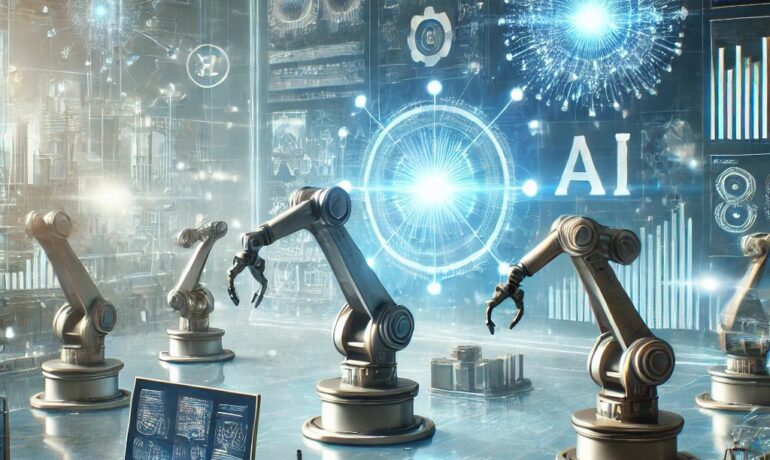Artificial Intelligence (AI) is reshaping business operations by automating tasks, optimizing processes, and improving decision-making. As AI-powered automation continues to evolve, organizations are leveraging its capabilities to enhance efficiency, reduce costs, and drive innovation. From customer service chatbots to predictive analytics and robotic process automation (RPA), AI is revolutionizing industries across the board. At GM Pacific, we help businesses harness AI automation to stay competitive in the fast-changing digital landscape.
Understanding AI-Powered Automation
AI-powered automation integrates machine learning, natural language processing (NLP), and data analytics into business operations, enabling systems to perform tasks with minimal human intervention. Unlike traditional automation, which relies on predefined rules, AI-driven automation continuously learns and adapts, improving efficiency and accuracy over time.
Key technologies in AI automation include:
- Machine Learning (ML): Enables systems to analyze data, detect patterns, and make intelligent predictions.
- Natural Language Processing (NLP): Allows machines to understand and respond to human language, powering chatbots and virtual assistants.
- Computer Vision: Enables AI to process and interpret visual data, widely used in quality control, facial recognition, and autonomous systems.
- Robotic Process Automation (RPA): Automates repetitive, rule-based tasks, reducing manual effort and errors.
The Impact of AI Automation on Business Operations
1. Enhanced Productivity and Efficiency
AI-powered automation accelerates workflows by handling time-consuming tasks such as data entry, report generation, and customer inquiries. By reducing human workload, businesses can allocate resources more strategically, focusing on higher-value tasks that require human creativity and decision-making.
2. Cost Reduction
Automating repetitive tasks lowers operational costs by minimizing labor expenses and reducing errors. AI also optimizes resource utilization, ensuring that businesses operate more efficiently with fewer wasted resources.
3. Improved Customer Experience
AI-driven chatbots and virtual assistants provide instant support, improving response times and customer satisfaction. Intelligent recommendation engines personalize user interactions, enhancing engagement and loyalty.
4. Data-Driven Decision Making
AI analytics tools process vast amounts of data in real time, providing businesses with actionable insights. Predictive analytics helps organizations anticipate market trends, optimize inventory management, and enhance strategic planning.
5. Enhanced Security and Compliance
AI-powered monitoring systems detect anomalies in network activity, preventing security breaches and ensuring regulatory compliance. Automated compliance checks reduce the risk of human errors in financial reporting and data governance.
AI Automation in Key Industries
1. Healthcare
- AI-Powered Diagnostics: AI assists in diagnosing diseases by analyzing medical images and patient records.
- Automated Administrative Tasks: AI streamlines patient scheduling, billing, and claims processing.
- Drug Discovery: AI accelerates pharmaceutical research by identifying potential drug candidates faster.
2. Finance and Banking
- Fraud Detection: AI analyzes transaction patterns to identify fraudulent activities in real time.
- Algorithmic Trading: AI-driven algorithms optimize trading strategies based on market conditions.
- Customer Support Automation: AI chatbots handle inquiries, reducing wait times for banking services.
3. Manufacturing and Supply Chain
- Predictive Maintenance: AI monitors machinery performance to predict failures before they occur.
- Supply Chain Optimization: AI forecasts demand, optimizing inventory levels and logistics.
- Quality Control: AI-powered computer vision detects defects in manufacturing processes.
4. Retail and E-Commerce
- Personalized Shopping Experiences: AI recommends products based on customer preferences and browsing history.
- Automated Inventory Management: AI predicts demand fluctuations and automates restocking.
- AI-Powered Chatbots: Virtual assistants enhance customer service and support.
5. Human Resources and Workforce Management
- Resume Screening and Recruitment: AI automates candidate screening, identifying the best-fit applicants.
- Employee Productivity Tracking: AI monitors workflow efficiency and suggests improvements.
- Training and Upskilling: AI-powered learning platforms personalize employee training programs.
Challenges of AI-Powered Automation
1. Integration Complexity
Implementing AI automation requires seamless integration with existing IT infrastructure, which can be complex and costly. Businesses must ensure compatibility with legacy systems while adopting AI-driven solutions.
2. Data Privacy and Security Risks
AI systems rely on vast amounts of data, raising concerns about data privacy and regulatory compliance. Organizations must implement strong cybersecurity measures to protect sensitive information.
3. Workforce Displacement Concerns
AI automation can replace certain jobs, raising concerns about workforce displacement. However, organizations can mitigate this by investing in upskilling initiatives and transitioning employees into higher-value roles.
4. Ethical Considerations and Bias
AI models can inherit biases from training data, leading to unfair outcomes. Businesses must implement transparent AI governance to ensure ethical decision-making and minimize bias.
The Future of AI-Powered Automation
As AI continues to advance, its impact on automation will grow, driving new innovations and efficiencies. Key trends shaping the future of AI automation include:
1. AI-Augmented Decision Making
AI will act as a co-pilot for business leaders, providing intelligent recommendations and assisting in strategic decision-making.
2. Hyperautomation
The combination of AI, RPA, and advanced analytics will drive hyperautomation, where businesses automate entire workflows, reducing human intervention to a minimum.
3. Autonomous AI Systems
AI-driven systems will operate with minimal human oversight, optimizing processes in real time and adapting to changing conditions.
4. AI and IoT Integration
AI-powered automation will integrate with IoT devices, enabling smarter decision-making in industries such as smart cities, healthcare, and logistics.
Conclusion
AI-powered automation is revolutionizing business operations, driving efficiency, cost savings, and innovation. By leveraging AI-driven solutions, organizations can enhance productivity, improve customer experiences, and stay competitive in the digital economy. At GM Pacific, we help businesses integrate AI automation into their operations, ensuring seamless adoption and maximum value.
For more information on how GM Pacific can assist in implementing AI automation strategies, contact us today.
